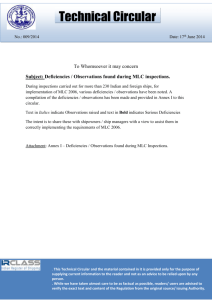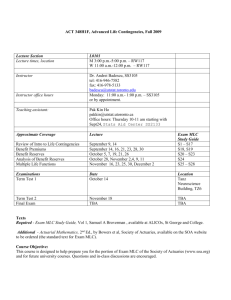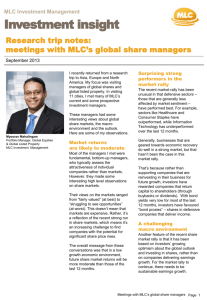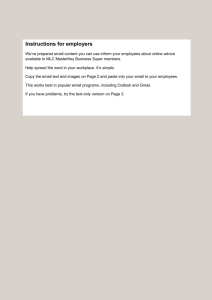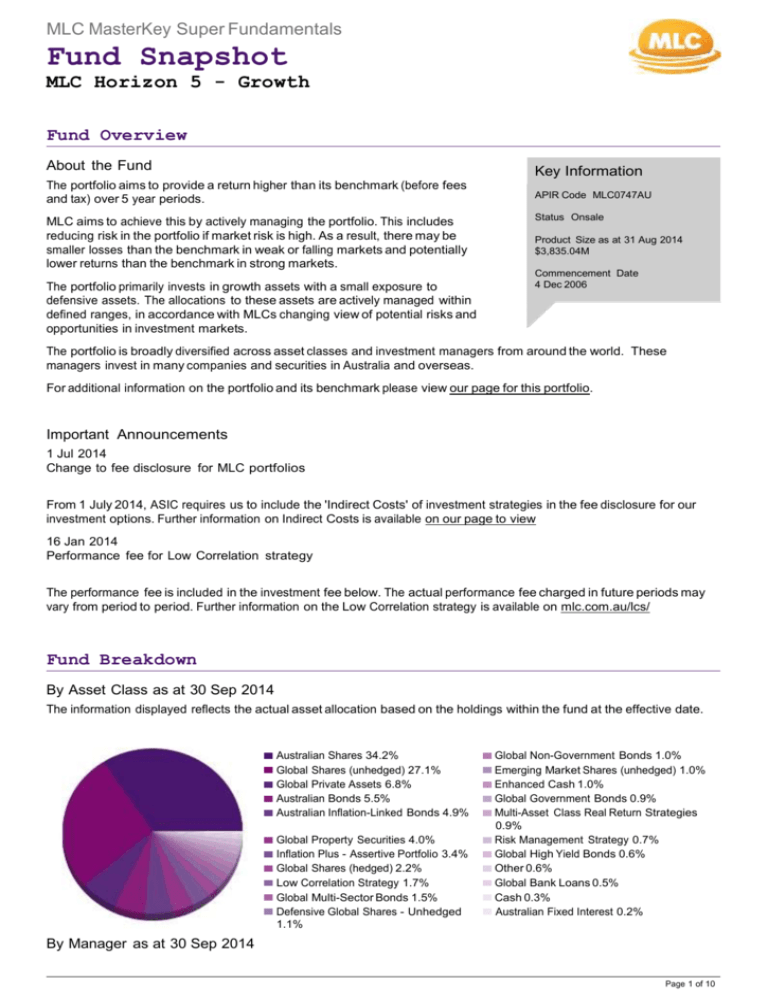
MLC MasterKey Super Fundamentals
Fund Snapshot
MLC Horizon 5 - Growth
Portfolio
Fund Overview
About the Fund
Key Information
The portfolio aims to provide a return higher than its benchmark (before fees
and tax) over 5 year periods.
MLC aims to achieve this by actively managing the portfolio. This includes
reducing risk in the portfolio if market risk is high. As a result, there may be
smaller losses than the benchmark in weak or falling markets and potentially
lower returns than the benchmark in strong markets.
The portfolio primarily invests in growth assets with a small exposure to
defensive assets. The allocations to these assets are actively managed within
defined ranges, in accordance with MLCs changing view of potential risks and
opportunities in investment markets.
APIR Code MLC0747AU
Status Onsale
Product Size as at 31 Aug 2014
$3,835.04M
Commencement Date
4 Dec 2006
The portfolio is broadly diversified across asset classes and investment managers from around the world. These
managers invest in many companies and securities in Australia and overseas.
For additional information on the portfolio and its benchmark please view our page for this portfolio.
Important Announcements
1 Jul 2014
Change to fee disclosure for MLC portfolios
From 1 July 2014, ASIC requires us to include the 'Indirect Costs' of investment strategies in the fee disclosure for our
investment options. Further information on Indirect Costs is available on our page to view
16 Jan 2014
Performance fee for Low Correlation strategy
The performance fee is included in the investment fee below. The actual performance fee charged in future periods may
vary from period to period. Further information on the Low Correlation strategy is available on mlc.com.au/lcs/
Fund Breakdown
By Asset Class as at 30 Sep 2014
The information displayed reflects the actual asset allocation based on the holdings within the fund at the effective date.
Australian Shares 34.2%
Global Shares (unhedged) 27.1%
Global Private Assets 6.8%
Australian Bonds 5.5%
Australian Inflation-Linked Bonds 4.9%
Global Property Securities 4.0%
Inflation Plus - Assertive Portfolio 3.4%
Global Shares (hedged) 2.2%
Low Correlation Strategy 1.7%
Global Multi-Sector Bonds 1.5%
Defensive Global Shares - Unhedged
1.1%
Global Non-Government Bonds 1.0%
Emerging Market Shares (unhedged) 1.0%
Enhanced Cash 1.0%
Global Government Bonds 0.9%
Multi-Asset Class Real Return Strategies
0.9%
Risk Management Strategy 0.7%
Global High Yield Bonds 0.6%
Other 0.6%
Global Bank Loans 0.5%
Cash 0.3%
Australian Fixed Interest 0.2%
By Manager as at 30 Sep 2014
Page 1 of 10
MLC MasterKey Super Fundamentals
Fund Snapshot
MLC Horizon 5 - Growth
Portfolio
Page 2 of 10
MLC MasterKey Super Fundamentals
Fund Snapshot
MLC Horizon 5 - Growth
Portfolio
Asset Class
Australian Bonds
Manager
Percentage
Investment Amount
Antares
2.7%
$271
UBS
2.8%
$280
Australian Fixed Interest
Antares
0.2%
$18
Australian Inflation-Linked Bonds
Antares
4.9%
$492
Australian Shares
Alphinity Investment Management
5.4%
$543
Antares
6.0%
$596
JCP
5.4%
$540
Northcape
4.0%
$397
Other
1.7%
$167
Redpoint
6.2%
$619
Vinva
5.5%
$553
Cash
Cash
0.2%
$23
Defensive Global Shares - Unhedged
International Value Advisors
1.1%
$111
Emerging Market Shares (unhedged)
Capital International
1.0%
$98
Enhanced Cash
Antares
1.0%
$97
Global Bank Loans
Shenkman Capital
0.5%
$47
Global Government Bonds
Goldman Sachs
0.9%
$91
Global High Yield Bonds
Oaktree
0.2%
$25
W.R. Huff
0.2%
$23
Amundi
0.4%
$36
Franklin Templeton
0.2%
$25
PIMCO
0.7%
$72
Peridiem
0.2%
$19
Loomis
0.5%
$52
Global Multi-Sector Bonds
Global Non-Government Bonds
Wellington Management
0.5%
$50
Global Private Assets
MLC Global Private Markets
6.8%
$680
Global Property Securities
Morgan Stanley
1.4%
$140
Other
0.2%
$24
Presima
0.9%
$92
Resolution Capital
1.4%
$140
Carnegie Asset Management
0.3%
$28
Dimensional
0.3%
$28
Harding Loevner
0.3%
$33
Jackson Square Partners
0.3%
$26
Kiltearn Partners
0.2%
$16
Sands Capital
0.3%
$28
Tweedy, Browne
0.3%
$31
Walter Scott
0.3%
$33
Carnegie Asset Management
3.5%
$354
Dimensional
3.2%
$319
Harding Loevner
3.8%
$375
Jackson Square Partners
2.9%
$295
Kiltearn Partners
2.0%
$199
Other
0.6%
$57
Sands Capital
3.2%
$323
Tweedy, Browne
3.6%
$362
Walter Scott
4.3%
$425
Inflation Plus - Assertive Portfolio
LTAR Multi-Manager Approach
3.4%
$340
Low Correlation Strategy
MLC Alternative Strategies
1.6%
$163
Global Shares (hedged)
Global Shares (unhedged)
Page 3 of 10
MLC MasterKey Super Fundamentals
Fund Snapshot
MLC Horizon 5 - Growth
Portfolio
Multi-Asset Class Real Return Strategies
Pyrford
0.3%
$29
Ruffer
0.6%
$61
Other
Other
0.9%
$87
Risk Management Strategy
MLC Investment Management
Total
0.7%
$68
100.0%
$10,000
Stock Holdings
Top Stocks for Fund as at 31 Aug 2014
The Top Stocks for Fund have a one month reporting delay.
Stock Description
Industry
Country
Percentage
Investment Amount
COMMONWEALTH BANK OF AUSTRALIA
Financials
Australia
3.0%
$300
BHP BILLITON
Materials
Australia
3.0%
$298
WESTPAC BANKING CORP
Financials
Australia
3.0%
$296
ANZ BANKING GROUP
Financials
Australia
2.6%
$257
TELSTRA CORP
Telecommunication Services
Australia
2.0%
$205
NATIONAL AUSTRALIA BANK
Financials
Australia
1.8%
$175
WOOLWORTHS LTD
Consumer Staples
Australia
1.0%
$96
RIO TINTO
Materials
Australia
1.0%
$96
WESFARMERS
Consumer Staples
Australia
0.9%
$88
QBE INSURANCE GROUP
Financials
Australia
0.7%
$71
Page 4 of 10
MLC MasterKey Super Fundamentals
Fund Snapshot
MLC Horizon 5 - Growth
Portfolio
Performance
Historical Performance
Absolute Fund Returns as at 30 Sep 2014
Returns for periods one year or greater are calculated on an annualised basis. All returns are calculated using end of
month redemption prices assuming all distributions are reinvested and are net of management fees which may include
administration fees, issuer fees and investment fees and prior to any individual tax considerations, and do not allow for
initial entry fees.
The returns outlined below represent historical performance only and is not an indication of future performance. The value
of an investment may rise or fall with changes in the market. Returns are calculated in accordance with FSC Standard No
6.
3 month
6 month
1 Year
2.1%
4.2%
9.5%
Fund Performance
3 Years
13.2%
5 Years
7.9%
10 Years
N/A
Since
Inception
4 Dec 2006
3.7%
Commentaries
Fund Commentary
As at 30 September 2014
The portfolio produced a return of 2.3% in the quarter and 11.3% in the year to 30 September 2014 (before fees and tax).
Contributors to performance
Key contributors to performance for the quarter and the year are in the following table. Returns are before fees and tax.
For the quarter
For the year
Page 5 of 10
MLC MasterKey Super Fundamentals
Fund Snapshot
MLC Horizon 5 - Growth
Portfolio
The portfolios global shares (unhedged) strategy delivered a
very strong return of 5.6%. Global shares performed well in the
quarter despite market volatility beginning to increase in the
month of September. Improving economic data from the US
and accommodative monetary policy continued to push share
prices higher around the world.
The portfolios global private assets strategy produced a very
strong return of 6.0%.
The multi-asset real return strategy produced a return of 3.2%
over the quarter.
The portfolios return for the year was strong.
The portfolios investment in the global shares (unhedged)
strategy delivered a very strong return of 17.9%. Five of seven
managers underperformed the broader market for the year (the
eighth manager, Kiltearn, has been in the portfolio for less than
a year). Strong performance by Carnegie couldnt overcome the
drag caused by Jackson Square Partners and Walter Scott.
The Australian shares strategy delivered a return of 5.4%. The
Australian economy continues to expand at a moderate pace,
despite continued weakness in mining investment. There are
signs that the non-mining economy is improving: housing
activity is picking up, business investment outside of the mining
industry is starting to grow, and private sector credit growth has
been accelerating. However, whether this pick-up in
non-mining activity will be sufficient to offset weaker mining
investment is still unclear.
Global private assets delivered an extremely strong return of
21.6%.
Performance relative to the benchmark
The portfolio has achieved its return objective to provide a return higher than its benchmark (before fees and tax) over 5
year periods. Over the 5 years to 30 September 2014, the portfolio has outperformed its benchmark by 0.3% pa. And by
applying the Investment Futures Framework MLC continues to reduce risk in the portfolio when market risk is high, as
explained below.
Portfolio positioning
These are currently the main positions in the portfolio. In the September quarter, we made small changes to increase the
portfolios defensive positioning, relative to its benchmark, before the Australian share market decline in September.
In recent quarters, several factors have combined to increase the risk of a further market correction. These include the
prospect of more normal monetary policy in the US, slowing global growth and the possibly of renewed recession in
Europe, the spread of Ebola, and a worrying mix of other geopolitical factors. While none of these factors is new, the risk
of each has intensified. Because of these factors, along with stretched market valuations, the portfolio had been
positioned more defensively before the September market decline. So far, the decline in share prices has not been
enough to offset the rise in risk, which meant that at the end of the September quarter the portfolio remained defensively
positioned.
Page 6 of 10
MLC MasterKey Super Fundamentals
Fund Snapshot
MLC Horizon 5 - Growth
Portfolio
Portfolio position compared with
benchmark
Why we have the position
Impact on performance
Below benchmark exposure to
growth assets
We have implemented this position by:
The portfolio has a large exposure to shares to generate
long-term returns. However, because shares can be volatile,
weve increased the portfolios diversification over time to
manage risk and generate more robust returns. These
risk-controlled exposures include multi-asset real return
strategies, the Low Correlation Strategy, a multi-asset emerging
markets strategy and the defensive global shares strategy.
During the September quarter, these strategies helped reduce
exposure to declining share markets.
As these strategies were introduced to the portfolio, we
reduced allocations that invest in the broader Australian and
global share markets.
For the last few years share market returns, supported by
unusually low interest rates, have been strong and have tended
to run ahead of actual company earnings. When market returns
have been strong for a long period, there is increased risk that
share valuations become stretched, and that markets may fall.
In the September quarter, there were signs of a change in the
share markets behaviour, with higher volatility and the US
Federal Reserve being less able to soothe market concerns.
As a result, during the quarter there was a limited reversal of
strong share market returns. However, our assessment remains
that the decline in share prices has not been enough to offset
the rise in the risk of a market correction. Potential negative
scenarios for growth assets (such as shares) include
Developed market austerity, Recession, Stagnation and
China hard landing.
The portfolio will continue to benefit from strong returns in
positive scenarios for growth assets, such as a Mild
inflationary resolution or an Early re-leveraging scenario. In
these scenarios, growth assets should perform strongly
compared to bonds.
Another positive scenario for growth assets is Extended
quantitative easing. This scenario is starting to emerge in
Europe due to weak economic data. In this scenario market
expectations of more monetary stimulus could push growth
assets higher.
Our below benchmark exposure to growth assets is consistent
with the views of a number of our investment managers that the
risk of a negative environment for growth assets has risen.
By further reducing the allocation to
Australian shares before the market
decline in September, the portfolio
benefited from the strong share
market performance of previous
months.
This position may mean the portfolios
returns will be slightly lower if share
markets rebound from Septembers
decline. However, we consider the
position is appropriate given the
current risk level and the increased
protection it will provide if negative
scenarios occur.
While government bond yields (interest rates on bonds) could
decline from their already low levels, the potential for further falls
is less than the potential for yields to rise. Rising yields means
bond prices fall and there is the potential for negative returns.
By reducing the duration, weve reduced the risk of negative
returns if yields rise, such as in a Sovereign yield re-rating
scenario.
Shortening the duration of our government bond strategy will
also give the portfolio some protection if inflation eventually
rises. In a Rising inflation or Inflation shock scenario,
traditional bonds would perform poorly and could deliver
negative returns.
We also recently increased the portfolios exposure to
inflation-linked bonds to benchmark level. Although the yields
on these bonds are quite low, their returns move with inflation
(unlike traditional bonds). This means they can help protect
against the risk of rising inflation.
Global government bond yields rose
in September, benefiting
performance. However, yields fell
earlier in the year, reducing the
portfolios one year returns.
reducing the Australian shares
allocation and
1. increasing exposure to the
Low Correlation Strategy.
Below benchmark exposure to
interest rate risk
We have implemented this position by:
reducing the duration
(exposure to changes in bond
interest rates) of our
government bond strategy,
and
tilting the portfolio away from
global bonds and towards
cash and Australian bonds.
Page 7 of 10
MLC MasterKey Super Fundamentals
Fund Snapshot
MLC Horizon 5 - Growth
Portfolio
Above benchmark exposure to
foreign currencies
We have implemented this position by:
reducing the allocation to
global shares whose foreign
currency exposure is hedged
to the Australian dollar
increasing exposure to
unhedged global shares, and
maintaining unhedged
exposures in most global
growth assets.
When designing the portfolio, we aim to combine assets and
strategies which perform differently in different scenarios. Global
share markets and the Australian dollar (AUD) tend to move in
the same direction. So by having an exposure to foreign
currencies (that is, not hedging some of our overseas assets to
the AUD) we can help insulate our portfolios against losses
when share markets fall.
Foreign currency exposure is therefore an important diversifier
of risk for the portfolio. We expect that it will help generate more
robust returns, even though the Australian dollar (AUD) has
declined from its highest point. Our above benchmark position
is intended to reduce the portfolios exposure to negative returns
in a number of negative scenarios, including China hard
landing.
Its important to note that our portfolio positioning doesnt
assume that the AUD will decline. We also consider scenarios in
which the AUD rises, including Extended quantitative easing
and Sovereign yield re-rating. However, in many scenarios we
expect the AUD to fall further, particularly if share prices fall
sharply. These scenarios include China hard landing.
The AUD and global share markets
fell in September. Our foreign
currency exposure worked well this
quarter, offsetting the negative
market returns.
During the year the overweight
foreign currency exposure has helped
to reduce the volatility of returns.
Changes to the portfolio
To reflect the positions outlined in the table above, during the quarter we:
reduced the allocation to Australian shares by 1%,
increased the allocation to the low correlation strategy by 1%,
reweighted our global property securities managers, and
appointed Loomis as a global non-government bonds manager and removed Rogge. The global non-government
bonds manager allocations in our fixed income strategies have delivered strong returns over the last three years.
We believe we can further improve the returns and risk control of these allocations by replacing Rogge with
Loomis. Thats because Loomis investment approach, which is based on bottom-up relative value research, is
different from and complementary to the top-down approach of Wellington (the other manager in the allocation).
Note:
- Please refer to the Market commentary for an overview of what happened in domestic and global markets over the
quarter.
- Fund commentary for this fund will be updated two to three weeks after the end of the month
Page 8 of 10
MLC MasterKey Super Fundamentals
Fund Snapshot
MLC Horizon 5 - Growth
Portfolio
Market Commentary
As at September 2014
Returns to 30 September 2014*
Asset class
3 mth (%)
1yr (%)
3yr (%)
5yr (%)
10yr (%)
Cash
0.7
2.6
3.4
3.9
4.9
Australian bonds
1.0
6.0
5.8
6.7
6.3
Global investment grade bonds (hedged)
1.8
8.1
7.1
8.0
7.6
A-REITs
1.1
12.2
18.9
8.6
1.9
Global REITs (hedged)
-1.3
12.0
19.8
15.8
na
Australian shares
-0.6
5.9
14.8
6.8
8.4
Global shares (hedged)
2.0
18.3
22.0
14.3
9.6
Global shares (unhedged)
5.5
19.6
21.4
10.8
5.8
Sources: Datastream, MLC Investment Management. *Annualised returns except for 3 month.
Benchnark data include UBS Bank Bill Index (Cash), UBS Composite Index (Aust bonds) Barclays Global Aggregate hedged to A$ (Global bonds),
S&P/ASX200 A-REIT Accumulation Index (A-REITs), MLC Global property strategy benchmark hedged to A$ (Global REITs), S&P/ASX200
Accumulation index (Aust shares) and MLC global equity strategy benchmark (MSCI All Country Indices hedged and unhedged in A$).
World share markets managed to post solid gains over the September quarter, despite declines in US and UK share
prices and some key emerging markets during September. Unhedged global share returns were boosted by a sharply
lower Australian dollar, which fell below US90c in September.
The Australian share market had a disappointing quarter. Bank shares fell on concerns about the possibility of regulatory
intervention in lending markets (particularly housing) and possible changes to capital requirements, which could impede
the banks future profitability. Mining shares also dropped sharply as the price of iron ore fell to five-year lows.
Government bond yields were little changed in the US, but declined in most other world bond markets, allowing bond
investors to enjoy reasonable gains during the quarter.
Share prices continued to benefit from extraordinarily easy monetary policy, despite the impending end of the US Federal
Reserves quantitative easing program, and a stronger global economy, largely due to a clear improvement in US growth.
Indications of renewed weakness in the eurozone have prompted the European Central Bank to adopt further monetary
measures to boost growth.
Geopolitical concerns continued to periodically trouble financial markets. The Ukrainian crisis remains unresolved, even
though there have been efforts to secure a ceasefire. The so-called Islamic State remains in control of large swathes of
Syria and north-western Iraq, despite the commencement of US and allied airstrikes against it.
The Australian economy continues to expand at a moderate pace in spite of continued weakness in mining investment.
There are signs that the non-mining economy is improving: housing activity is picking up, business investment outside the
mining industry is starting to grow, and private sector credit growth has been accelerating. However, whether this pick-up
in non-mining activity will be sufficient to offset weaker mining investment is still unclear.
The Reserve Bank of Australia kept interest rates on hold over the quarter and has signalled its intention to leave rates
unchanged for some time to come. At just 2.5%, the official cash rate remains at its lowest level in living memory. While
Australias economic growth is far from spectacular, the economy does not appear weak enough to reduce rates further,
particularly given concerns about a potentially overheated property market. However, the economy not is strong enough
to warrant higher interest rates at this point.
Page 9 of 10
MLC MasterKey Super Fundamentals
Fund Snapshot
MLC Horizon 5 - Growth
Portfolio
Information in this report does not take into account your objectives, financial situation or needs. Before acting on the information you should consider
whether it is appropriate to your situation. You should consider the relevant Product Disclosure Statement before making a decision about the product.
Past performance is not a reliable indicator of future performance. Please also see Advice Warning and Important Information.
MLC Limited (ABN 90 000 000 402 AFSL 230694) is the issuer of:
MLC MasterKey Investment Bond
MLC Nominees Pty Ltd (ABN 93 002 814 959 AFSL 230702 Trustee of The Universal Super Scheme ABN 44 928 361 101) is the issuer of:
MLC MasterKey Business Super (including MLC MasterKey Personal Super), MLC MasterKey Superannuation, MLC MasterKey Super, MLC MasterKey
Super Fundamentals, MLC MasterKey Allocated Pension, MLC MasterKey Pension, MLC MasterKey Pension Fundamentals, MLC MasterKey Term
Allocated Pension
MLC Investments Limited (ABN 30 002 641 661, AFSL number 230705) is the issuer or operator of:
MLC Investment Trust, MLC MasterKey Investment Service, MLC MasterKey Investment Service Fundamentals, MLC MasterKey Unit Trust, MLC
Investments Limited also trades as MLC Private Investment Consulting.
NULIS Nominees (Australia) Limited (ABN 80 008 515 633 AFSL 236465):
trustee of the MLCS Superannuation Trust ABN 31 919 182 354 is the issuer of Navigator Eligible Rollover Fund ABN 32 649 704 922;
trustee of the MLC Superannuation Fund ABN 40 022 701 955 is the issuer of MLC Wrap Super and MLC Navigator Retirement Plan.
Navigator Australia Limited (ABN 45 006 302 987 AFSL 236466) is the Operator and issuer of:
MLC Wrap Investments, MLC Wrap Self Managed Super and MLC Navigator Investment Plan.
© You are only authorised to use the data and content for the purpose of research, validation and monitoring of your personal investments. You may not
redistribute the data and content to any other person under any circumstances.
2013 Morningstar, Inc. All rights reserved. The data and content contained herein are not guaranteed to be accurate, complete or timely. Neither
Morningstar, nor its affiliates nor their content providers will have any liability for use or distribution of any of this information. To the extent that any of the
content above constitutes advice, it is general advice that has been prepared by Morningstar Australasia Pty Ltd ABN: 95 090 665 544, AFSL: 240892
(a subsidiary of Morningstar, Inc.), without reference to your objectives, financial situation or needs. Before acting on any advice, you should consider the
appropriateness of the advice and we recommend you obtain financial, legal and taxation advice before making any financial investment decision. If
applicable investors should obtain the relevant product disclosure statement and consider it before making any decision to invest. Some material is
copyright and published under licence from ASX Operations Pty Limited ACN 004 523 782 ("ASXO"). DISCLOSURE: Employees may have an interest in
the securities discussed in this report. Please refer to our Financial Services Guide (FSG) for more information at http://www.morningstar.com.au/fsg.asp
Page 10 of 10



